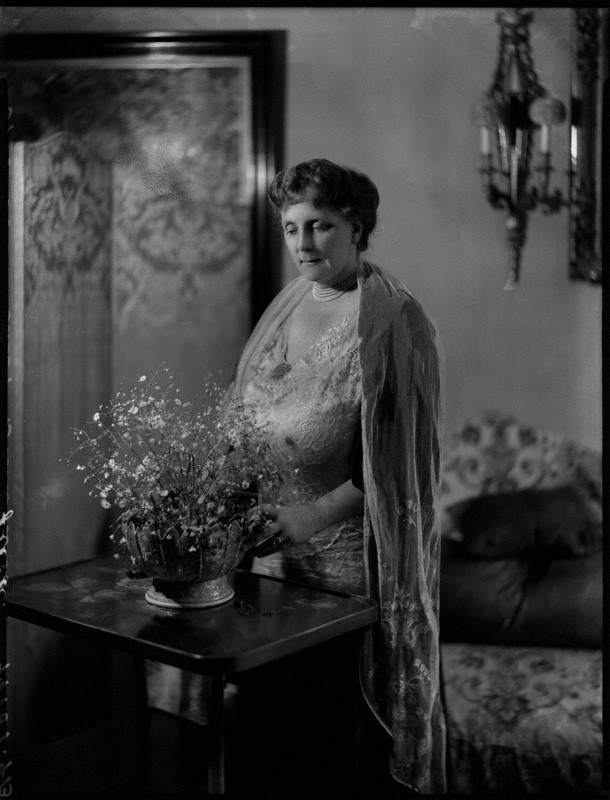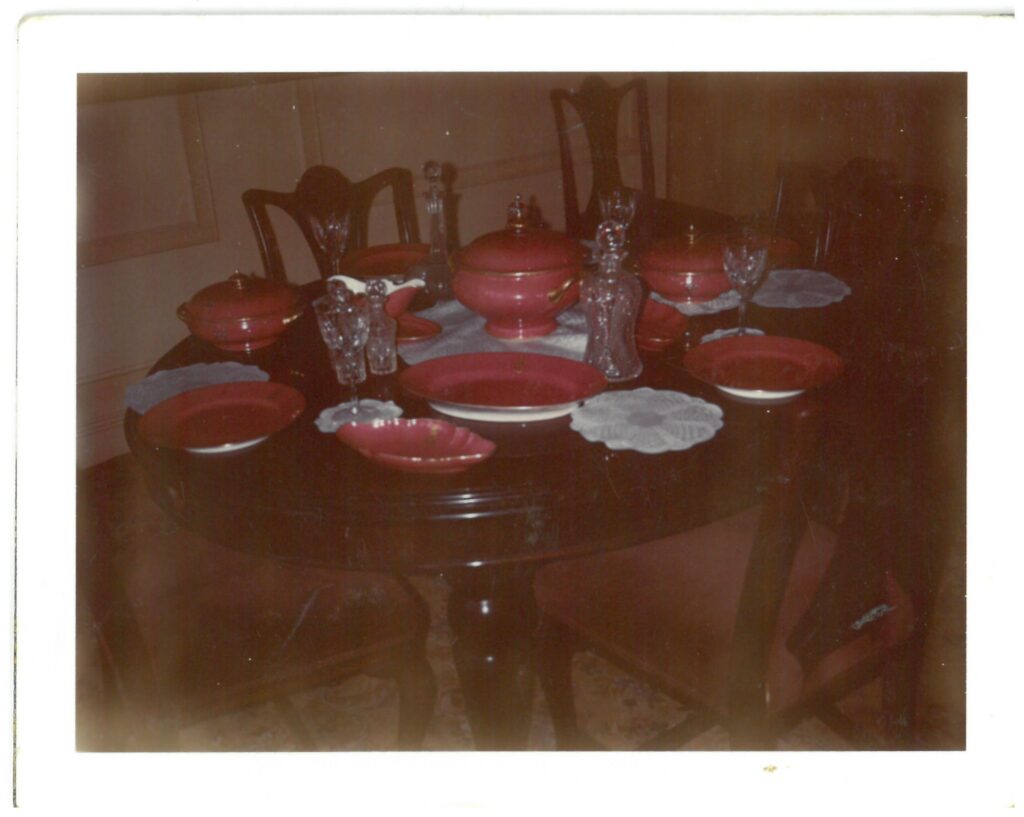Working in museums can be a bit like becoming a detective. We do research to find out what’s happened to a particular building or objects or figuring out ‘what happened next’ to someone linked to our collections or the buildings they’re housed in. There’s always something intriguing to find out.
We’ve been doing a bit of this recently at Cliffe Castle, so we thought we’d share some of what we’ve found out, along with asking for our readers for a bit of help in trying to solve another mystery….
Museum Manager North, Daru Rooke writes:
When we talk about the history of Cliffe Castle, one lady that we’ve not yet explored fully is Hilda Johnston Waters Butterfield, who married Frederick Butterfield to become the second Lady Butterfield. Our research has begun to show us that she has quite an interesting history in her own right.

whole-plate film negative, 31 May 1935 NPG x151369 © National Portrait Gallery, London
Hilda was born on the 15th August 1883 into the Milwaukee banking family of Johnston (Aberdonians who settled in the mid west in the mid 19th Century).
Hilda was the daughter of John Johnstone, president of the Marine National Bank and of the Board of Regents of the University of Wisconsin. Her Mother was Ethelinda Thorson Johnston of 2320 Bradford Avenue, Milwaukee. The family were noted philanthropists and gifted land to enable the creation of the Johnston Emergency Hospital in Milwaukee and funded the Johnston Hall at Milwaukee Downer College.
Hilda’s parents had a grand classical town house called Lion House in the centre of Milwaukee and a country estate with landscaped grounds and lakes known as Heather Brae. Photographs of both survive in the Johnston papers at Milwaukee Historical Society. Hilda’s Thorson grandparents were famous in the district for having the first plumbed in tin bath in the county!
Famous family members included Hilda’s cousin General William (Billy) Mitchell. General Billy was an early aeronaut who commanded a force of British, French and American flying corps in WWI and was responsible for the development of America’s own Air Force.
Hilda had a full education attending first Milwaukee Downer College, Vassar College and finally the Sorbonne in Paris. Her first marriage was to William L. Waters, an English engineer who had settled in New York. They were divorced in 1927.
According to Lady Rozelle Raynes, Hilda met the widower Sir Frederick Butterfield on a liner travelling to New York. Sir Frederick was drawn to the glamorous woman in the ocelot coat and they were married (to everyone’s surprise) in 1930. Lady Rozelle remembered her step- grandmother as being incredibly glamorous and vivacious.
The couple settled in the Butterfield’s ‘ancestral home’ Cliffe Castle, Keighley but had London town houses in Curzon Street and later a flat in South Street, the latter in the most modern art deco taste.
Lady Butterfield’s daughter from her first marriage (Carolinda, later Mrs Waters Fischer Jr. ) settled in England too and was presented at court in 1937. She studied at Bedford College London before returning to study at Vasser.
During her time at Cliffe Castle Lady Butterfield was said to have a staff of 25 servants, to have married someone just as wealthy as herself and to have spent approximately $1,000 a day.
Together with Sir Frederick she had glamorous holidays in Le Touquet and was known for participating as a milkmaid in the annual Ascension Day milking contest on the beach. Sadly Hilda’s Milwaukee milking style (approaching the cow from the left) frightened the animal so much it kicked over the bucket.
In 1936 an adventurous coach journey holiday around South American ended in the coach overturning and Hilda undergoing several major operations to bring her back to health as a result.
During the 1940s Hilda turned Cliffe Castle into the national base for the Children of the Fighting Forces war relief charity and it was the location from which 45,000 toys, 25,000 pairs of shoes, 74,000 pounds of apples and 6000 pounds of chocolate were distributed to children whose parents were serving in the war.
In later life Hilda became passionate about World Peace and launched a worldwide campaign to design a postage stamp that would make children aware of peace issues. The stamp was launched in Washington in 1956 and the stamp was issued by 44 countries.
During her time at the Castle, Hilda corresponded with many important 20th century characters including Winston Churchill and WB Yeats. These letters survive in the Hilda Johnston Butterfield collection at the New York public library.
After leaving Cliffe Castle in 1944 Hilda settled in the Colony Club in New York spending summers in Newport. She died in 1957 aged 73 and was cremated in Palm Beach.
If anybody has further information or memories of Hilda, we’d be interested to hear about them.
And now for the mystery, which we’re affectionately calling ‘Cliffe Castle and the search for Henry Isaac’s lost dinner service‘!
The Cliffe Castle team are always excited to hear about the original furnishings of the Victorian mansion that formed our museum. In 1950 many of the original fittings were sold at a four day auction. Lots included everything from the garden deckchairs to wineglasses owned by the poet Byron.
Recently a visitor explained what happened to Henry Isaac Butterfields’s vast pink dinner service. Apparently the visitor’s mother moved to a large Victorian house in 1950. Furnishing and equipping it was something of a problem so she visited several country house sales in the district. Here she could buy big, good quality pieces at a fair price.
At Cliffe Castle her attention was caught by a huge dinner service. It was made of porcelain possibly by the firm of Mansard’s of Paris and was enamelled in the most brilliant of shocking pinks described at the time as ‘Rose du Barry’. The pieces had gilded finials and handles and some were decorated with an N for Napoleon III and others a coroneted HIB for Henry Isaac Butterfield. It must have clashed wonderfully with the original dining room colour of crimson and gold.
Our visitor’s mother bought over 54 plates together with soup dishes, tureens, sauce boats and stands for 39 guineas. A local antique dealer bought another lot of the same service which ran to several hundred items.

Unfortunately the collection was sold again on the 7th of April 1983 by Spencer’s auction house in Leeds and has disappeared back into the community.
We would love to see a piece from this remarkable service and wonder if it is still in the district. If you have one of these amazing pieces of porcelain in your cupboard or on your dining table please get in touch. We would love to hear from you!
4 Responses
Afternoon I have just had an article published, Community and Family History 2017, in which Hilda is the central personality.
It covers who kinship groups and her status as an elite woman of wealth, her campaigns works post-war on a global scale and how that related to Carolinda’s success as a senior New York female lawyer during the 1960s.
Oh, that sounds fascinating, Iain (apologies for the delay in response, I’ve been on holiday!
Would you be able to point us in the direction of the article? We’d love to have a read!
Hilda seems to have had a plan to develop a Friendship Flag among the children of the world to promote international peace before 1950. Unesco Digital Library holds a document on the project. I wonder if you have any information on her plan for a Friendship Flag.
(https://unesdoc.unesco.org/ark:/48223/pf0000223503/PDF/223503eng.pdf.multi)
Yes, we believe so. She’s a fascinating woman – as were many of the ‘Butterfield Women’ – such an interesting group of women I’ve had the pleasure to do some small amounts of research on over the years!